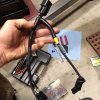ccmickelson
Well-Known Member
A good amount of progress this weekend. The parts are piling up. This is a fun but nerve-wracking project and I can tell you this job is not for the faint of heart and would seem all the more daunting without Growlerbearnz's engine install thread, http://www.delica.ca/forum/viewtopic.php?f=94&t=18908 (it would be like flying blind) and my buddy Tom giving me a hand.

Fluids drained, battery disconnected, radiator removed. Hoses and wiring loom disconnected, power steering pump and compressor moved out of the way. Is it too late to put it all back???

Left-front side and transmission bell-housing supported.

Hoist attached to lifting points and tensioned. We probably could have still taken up one more link in lifting chain. We finally removed the engine mount and bell-housing bolts.

It didn't come apart smoothly but did finally separate which probably means things were a little misaligned. After separation we eased the engine forward with just barely enough space front-to-back to raise it vertically.
My buddy Tom, helping finessing the beast out of the engine bay.

And then we had like a millimeter or two above the boom and below the sump to come clear, but it didn't hang up.

Unfortunately we did disturb the torque converter and ATF came rushing out. So we will need to replace that properly so as not to potentially damage the tranny.

My neighbor is going to lend me his engine stand for the old engine and then the new one will go on the hoist for the changeover of parts. It's way dirtier than it looks here in this pic. The turbo side is absolutely disgusting. (The turbo shit itself a few months ago driving up to the ski basin, so the Delica has been sitting, waiting for the swap. Didn't make a whole lot of sense to spend another $1K on a new turbo with a complete new engine sitting in the wings.)

Shame I won't be needing this spanking new clutch pack and flywheel. I'll figure out a price and put them up on the Parts for Sale.

Swapped over the original oil pressure sensor, bellhousing spacer, flexplate and a/c pulley. The sump, dipstick, some small brackets and a/c bracket need to wait until the engine is in the air. I think I'll keep the new alternator and install new plugs.

I think I'll tackle cleaning the engine bay next. Once I get the engine stand I will swap the sumps. That will be a messy job. There is a small list of parts I'll need to order as well. I'll post a pic of my list once I feel it's complete.

Fluids drained, battery disconnected, radiator removed. Hoses and wiring loom disconnected, power steering pump and compressor moved out of the way. Is it too late to put it all back???

Left-front side and transmission bell-housing supported.

Hoist attached to lifting points and tensioned. We probably could have still taken up one more link in lifting chain. We finally removed the engine mount and bell-housing bolts.

It didn't come apart smoothly but did finally separate which probably means things were a little misaligned. After separation we eased the engine forward with just barely enough space front-to-back to raise it vertically.
My buddy Tom, helping finessing the beast out of the engine bay.

And then we had like a millimeter or two above the boom and below the sump to come clear, but it didn't hang up.

Unfortunately we did disturb the torque converter and ATF came rushing out. So we will need to replace that properly so as not to potentially damage the tranny.

My neighbor is going to lend me his engine stand for the old engine and then the new one will go on the hoist for the changeover of parts. It's way dirtier than it looks here in this pic. The turbo side is absolutely disgusting. (The turbo shit itself a few months ago driving up to the ski basin, so the Delica has been sitting, waiting for the swap. Didn't make a whole lot of sense to spend another $1K on a new turbo with a complete new engine sitting in the wings.)

Shame I won't be needing this spanking new clutch pack and flywheel. I'll figure out a price and put them up on the Parts for Sale.

Swapped over the original oil pressure sensor, bellhousing spacer, flexplate and a/c pulley. The sump, dipstick, some small brackets and a/c bracket need to wait until the engine is in the air. I think I'll keep the new alternator and install new plugs.

I think I'll tackle cleaning the engine bay next. Once I get the engine stand I will swap the sumps. That will be a messy job. There is a small list of parts I'll need to order as well. I'll post a pic of my list once I feel it's complete.
Last edited:
































